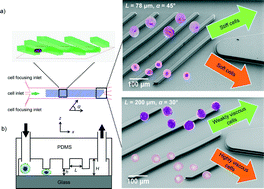We report a microfluidic approach to separate and enrich a mixture of two cell types based on differences in cell viscoelastic behavior during repeated compressions and relaxation events. As proof of concept, we demonstrate that variations in viscoelasticity affect the flow trajectory of one type of leukemia cell line (K562) in relation to another leukemia cell line (HL60) as well as healthy leukocytes. These differences in cell trajectory can be utilized to enrich and sort K562 cells from HL60 cells and leukocytes. The microfluidic device utilizes periodic, diagonal ridges to compress and translate the cells laterally perpendicular to channel axis. The ridge spacing is tuned to allow relaxation of the K562 cells but not the HL60 cells or leukocytes. Therefore, the periodic compression laterally translates weakly viscous cells, while highly viscous cells respond to hydrodynamic circulation forces generated by the slanted ridges. As a result, cell sorting has strong dependency on cell viscosity. We use atomic force microscopy and high-speed optical microscopy to measure cell stiffness, cell relaxation rate constant, and cell size for all cell types. With properly designed microfluidic channels, we can optimize the enrichment of K562 cells from HL60 and leukocytes.
